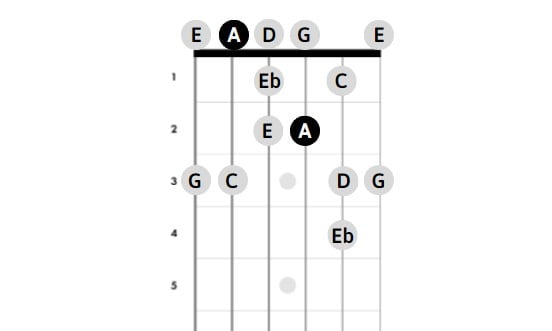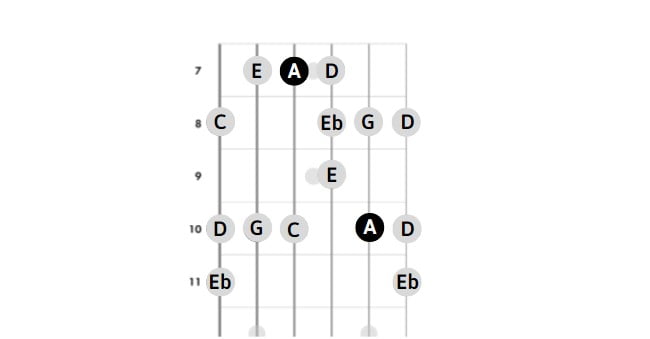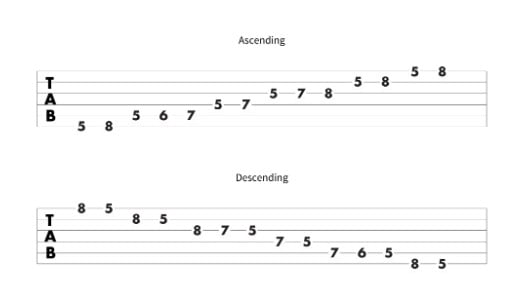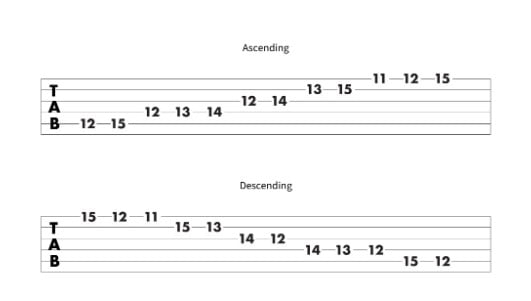In order to improvise over various chord progressions, from a classic 12-bar blues to a driving rock and roll song, mastering the blues scale is essential. This will not only enhance your improvisational skills but also help train your ear to learn new bluesy licks for your playing. Similar to pentatonic scales, the blues scale can be either major or minor. In this lesson, we will concentrate on one of the most popular blues scales, the A minor blues scale. We will cover how to play this scale in four different positions and teach you three movable minor blues scale shapes that will allow you to play in any key. Lastly, we will teach you how to play a 12-bar blues in A and provide some blues scale exercises.
Contents
Notes on the A minor blue scale
The A minor blues scale has six notes, namely:
- A
- C
- D
- D#
- E
- G
The intervals that make up this scale are the same in any key. These intervals are: a whole step and a half step, a whole step, a half step, a half step, a whole step and a half step, and a whole step. The fourth note in the scale, which is D# in this example, is commonly referred to as the blue note. The half steps that take you from D to D# to E produce the walking blues sound that is distinctive to this scale.
A minor blues scale positions
Similar to other scales, the A minor blues scale can be played in several positions on the guitar neck. In this lesson, we will focus on four different positions. When reading the guitar scale diagrams, keep in mind the following guidelines: O represents an open string, and the numbers on the diagrams correspond to your fretting fingers in the following order:
- Index finger
- Middle finger
- Ring finger
- Pinkie
Open position
When playing the A minor blues scale in 1st position, use your index finger for notes on the 1st fret, your middle finger for notes on the 2nd fret, your ring finger for notes on the 3rd fret, and your pinky for notes on the 4th fret.

5th position
To play the A minor blues scale in 5th position, use your index finger for notes on the 5th fret, your middle finger for notes on the 6th fret, your ring finger for notes on the 7th fret, and your pinkie for notes on the 8th fret. This scale commences on the 5th fret of the low E string. It is also referred to as an E-shaped blues scale.

7th position
To play the A minor blues scale in the 7th position, begin with your index finger on the 7th fret of the D string. When you reach the B string, you will need to shift your hand position up one fret to play notes on the 8th fret with your index finger. This scale is also referred to as the D-shaped blues scale.

12th position
To play the A minor blues scale in 12th position, begin with your index finger on the 12th fret of the A string. When you reach the B string, you must shift your hand position up one fret so that your index finger is on the 13th fret. After that, move your hand back to the starting position for the high E string. This scale is also called the A-shaped blues scale.
Blue scale tabs
After examining the guitar scale diagrams for the E-shaped, A-shaped, and D-shaped blues scales, here are some tabs that will show you how to play each of these scales in ascending and descending order. These scale shapes are movable, which means you can play them anywhere on the neck of your guitar. It will be beneficial to learn and memorize the notes on the E, A, and D strings of your guitar as you practice moving these scales up and down the fretboard.
E – Shaped blues scale
The E-shaped blues scale is so named because it begins on the low E string of your guitar. To play this scale in ascending and descending order, start with your index finger on the 5th fret of your low E string (A), and follow the tab.

A – Shaped blues scale
The A-shaped blues scale is called so because it begins on the A string of your guitar. To play this scale in ascending and descending order, start with your index finger on the 12th fret of the A string (A) and follow the tab. Remember to shift your hand position up one fret on the B string, then return to the starting position when you reach the high E string.

D – Shaped blues scale
To play the D-shaped blues scale in A minor, start on the seventh fret of the D string (A) and shift your hand up one fret when you reach the B string as you ascend the scale. When descending, shift your hand back to the starting position on the G string. However, you will need to be mindful of shifting your hand position up one fret on the B string as you play this scale.
Blues scale exercises
12-bar blues
The blues scale is a versatile scale that sounds great when paired with different chords, but it is particularly well-suited for 12-bar blues. The 12-bar blues typically consists of three chords, the I, IV, and V of a scale, which in the case of the A minor blues scale are A, D, and E. However, when playing a blues shuffle, you will play simplified versions of each chord on two strings instead of strumming them as you know them.
When playing 12-bar blues, you’ll notice that it sounds very familiar to your ear as you’ve heard it before in blues music, as well as early rock and roll and country songs. To get the right rhythm, play the 12-bar blues using downstrokes and emphasize the first and third beat of every measure. You might also hear this 12-bar blues referred to as a blues shuffle due to its shuffling rhythm. A guitar tab with a standard 12-bar blues pattern is included in this text.
To train your fingers and ears while learning this versatile scale, practice playing the A minor blues scale in each position. Once you’re comfortable playing the scales on your own, practice playing the A minor blues scale in each position with a looping accompaniment of the 12-bar blues in A, but with a syncopated rhythm. Play the scale in sections, treating the notes on each string as one phrase. Once you’re comfortable with this, experiment by breaking up the scale into three- or four-note sections across strings. Practicing your scales in this way will help you learn to improvise and may even lead you to discover some interesting licks or riffs of your own.
Different exercise
Another way to practice the blues scales on your guitar is to play each shape up and down the neck of your guitar. Start with the E-shaped blues scale and play each scale ascending and descending, beginning at the first fret and moving up one fret for each repetition of the shape. Play the scale in this way up to the thirteenth fret, then begin moving down one fret for each cycle until you arrive back at the first fret. This exercise will enable you to hear the scale in every key and help you memorize the notes on the E, A, and D strings by saying the root note of each scale as you go up and down the neck.
